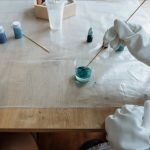If your new clothes bleed dye during the first wash, act fast. Remove the affected items immediately and check for dye transfer on other clothes. Rinse the stained area under cold water, applying gentle detergent to lift the stain. Avoid drying the items to prevent setting the dye. Wash new clothes separately in cold water and consider using color-catcher sheets to minimize future issues. Keep going to discover more tips for maintaining fabric quality and preventing stains.
Table of Contents
Key Takeaways
- Remove affected items from the wash immediately and check for dye transfer to other clothes.
- Rinse the stained area under cold water to dilute the dye.
- Apply gentle detergent to the stain, gently blotting with a clean cloth.
- Avoid drying the items; heat can set the dye and worsen the stain.
- Wash new clothes separately in cold water to reduce the risk of bleeding in future washes.
Understanding Color Bleeding in New Clothes
When you buy new clothes, you mightn’t realize that they can bleed dye during their first wash. This happens because the fabric’s dye hasn’t fully set, especially in vibrant colors.
Certain materials, like cotton or rayon, tend to be more prone to bleeding due to their dyeing processes. You may notice this issue more with darker shades or items with intense prints.
It’s important to understand that even high-quality garments can bleed, so don’t let brand reputation fool you. If you wash your new clothes with lighter items, the dye can transfer, ruining your favorite pieces.
Knowing this can help you take precautions, ensuring your wardrobe stays looking fresh and vibrant for longer.
Immediate Steps to Take After Color Bleeding
If you notice color bleeding on your new clothes, act quickly to minimize damage.
Start by evaluating the situation and identifying the extent of the stain.
Rinse the affected area with cold water and treat any stains immediately to prevent them from setting.
Act Quickly and Assess
Act fast to minimize damage when you notice color bleeding from your new clothes.
First, remove the affected items from the wash immediately. Check the other clothes in the load to see if they’ve picked up any unwanted dye. If they have, you’ll need to address that too.
Next, assess the severity of the bleeding. Is it a small, isolated spot or is it widespread? This will determine your next steps.
Make a note of the fabric type, as some materials react differently to treatments. Avoid drying the items, as heat can set the dye. Instead, keep them damp until you can take further action.
Your prompt response is essential in saving your clothes from permanent damage.
Rinse and Treat Stains
To tackle dye bleeding effectively, start by rinsing the affected area under cold water.
Make sure you do this as soon as possible to prevent the stain from setting. After rinsing, assess any remaining discoloration and treat it accordingly.
Here’s what you can do next:
- Apply a mixture of cold water and a gentle detergent to the stained area.
- Gently blot the stain with a clean cloth—don’t rub, as that can worsen the issue.
- Rinse thoroughly again with cold water to remove any soap residue.
- If the stain persists, consider using a stain remover specifically designed for color bleeding.
Taking these immediate steps can greatly improve your chances of restoring your garment to its original state.
Pre-Treating Affected Areas for Effective Removal
Once you’ve identified the affected areas on your clothes, it’s time to choose the right stain remover.
Apply it carefully to the spots where the dye has bled, making sure to follow the product instructions.
After letting it sit for the recommended time, rinse thoroughly to see the best results.
Identify Affected Areas
Identifying the affected areas on your clothing is essential for effective dye removal. Start by examining your garment carefully to pinpoint where the dye has bled. Look for discoloration or faded spots, which can help you focus your cleaning efforts.
To guarantee you don’t miss any spots, consider these tips:
- Check seams and hems, where dye often collects.
- Inspect areas that rubbed against other fabrics during washing.
- Look for any color transfer on light-colored sections.
- Use good lighting to spot subtle changes in color.
Once you’ve identified the affected areas, you can proceed with targeted treatments to maximize your chances of removing the dye. This focused approach can save your clothing from permanent discoloration.
Choose Stain Remover
Selecting the right stain remover is crucial for effectively pre-treating the affected areas of your clothing. You’ll want to choose a product specifically designed for dye stains, as these are often tougher to remove. Look for stain removers that contain enzymes or color-safe bleach options.
Here’s a quick comparison of common stain removers:
| Stain Remover Type | Effectiveness | Safe on All Fabrics |
|---|---|---|
| Enzyme-based | High | Yes |
| Color-safe Bleach | Medium | Yes |
| Oxygen Bleach | High | No |
| Dish Soap | Low | Yes |
| Vinegar | Low | Yes |
Always test a small area first to verify the remover won’t damage your fabric.
Apply and Rinse
To effectively pre-treat areas where dye has bled, start by applying your chosen stain remover directly to the affected spots.
Make sure to follow the instructions on the product for the best results. After applying, gently rub the fabric together or use a soft cloth to work the remover into the fibers.
Next, rinse the area with cold water to help lift the dye.
Here are some tips to enhance your pre-treatment process:
- Test the stain remover on a hidden area first.
- Use cold water to prevent dye from setting.
- Don’t scrub too hard to avoid damaging the fabric.
- Repeat the process if necessary until the stain disappears.
Washing Techniques to Minimize Dye Transfer
While it’s exciting to add new clothes to your wardrobe, you might worry about dye bleeding during the wash. To minimize dye transfer, always wash new items separately from your other clothes, especially in the first few washes.
Use cold water, as it helps prevent dyes from running. Opt for a gentle cycle to reduce agitation, which can cause fibers to release dye. Adding a cup of white vinegar to the wash can help set the dye, reducing bleeding.
If you’re worried about specific items, consider using a color catcher sheet designed to absorb loose dyes. Finally, avoid overloading the washing machine to guarantee clothes have enough space to move freely, which can also help in preventing dye transfer.
Preventive Measures for Future Washes
After taking steps to minimize dye transfer in your initial washes, you can implement additional preventive measures for future laundry loads.
By following these tips, you’ll keep your clothes looking vibrant and fresh:
- Separate Colors: Always wash whites, darks, and bright colors separately to prevent dye transfer.
- Cold Water Washes: Use cold water for washing, as it helps reduce the likelihood of dye bleeding.
- Shorter Cycles: Opt for shorter wash cycles to limit agitation, which can loosen dyes.
- Gentle Detergents: Choose detergents formulated for color protection, as they help maintain the integrity of fabric dyes.
The Role of Color-Catcher Sheets in Preventing Bleeding
If you want an extra layer of protection against dye bleeding during laundry, consider using color-catcher sheets.
For added protection against dye bleeding, try using color-catcher sheets in your laundry.
These handy sheets absorb excess dye released from new clothes, preventing it from settling on other fabrics. Simply toss a sheet into your wash, and it works silently in the background, capturing loose dye particles.
This can be particularly useful when washing mixed loads of light and dark colors. You’ll feel more confident throwing in that new red shirt with your favorite white jeans.
Just remember to replace the sheet after each wash, as it can only hold so much dye.
Long-Term Care for Maintaining Fabric Quality
To keep your clothes looking their best over time, it’s essential to adopt a few simple care habits.
By following these tips, you can maintain fabric quality and extend the life of your favorite garments:
- Wash in cold water to prevent fading and shrinking.
- Use gentle detergents specifically designed for delicate fabrics.
- Air dry when possible to minimize heat damage from dryers.
- Store properly, using padded hangers or folding to avoid creases.
Incorporating these practices into your routine will help you enjoy vibrant, well-maintained clothes for years to come.
With just a little effort, you can guarantee your wardrobe stays fresh and beautiful, allowing you to make the most of your fashion investments.
What to Avoid When Dealing With Color Bleeding
Maintaining fabric quality can only go so far when it comes to preventing color bleeding. To tackle this issue effectively, there are some common pitfalls you should avoid.
| Mistake | Why to Avoid It | Better Alternative |
|---|---|---|
| Washing with hot water | It can set stains and damage fibers | Use cold or lukewarm water |
| Mixing dark and light colors | This increases the risk of dye transfer | Wash similar colors together |
| Skipping pre-wash testing | You may miss potential bleeding | Always test a hidden area first |
Frequently Asked Questions
Can I Return Clothes That Bled Dye After the First Wash?
If your new clothes bled dye, you can typically return them, but check the store’s return policy. Be prepared to explain the issue and provide proof of purchase for a smooth exchange.
How Can I Tell if Dye Bleeding Is Permanent?
To tell if dye bleeding is permanent, check for fading or color transfer on other fabrics. If the stain remains after washing, it’s likely permanent. Always test a small area first before washing your clothes.
Will Color Bleeding Damage My Washing Machine?
Did you know nearly 20% of laundry accidents involve color bleeding? Fortunately, color bleeding usually won’t damage your washing machine. Just rinse the drum and run a cycle with white vinegar to keep it fresh.
Is It Safe to Use Fabric Softener on Bleeding Garments?
Using fabric softener on bleeding garments isn’t recommended. It can lock in the dye, making stains harder to remove. Instead, stick to gentle detergents and cold water to minimize further color transfer during washing.
Can I Use Heat to Set the Dye After Bleeding Occurs?
When it comes to setting dye, you can’t put all your eggs in one basket. Heat might help, but it often won’t fix bleeding. Consider using a color fixative for better results instead.
- Fabric Bleeding Nightmares: How to Avoid Them - June 10, 2025
- How to Safely Remove Dye Transfer Without Damaging Clothes - June 10, 2025
- Why Do Natural Dyes Bleed More and How to Control It? - June 10, 2025






